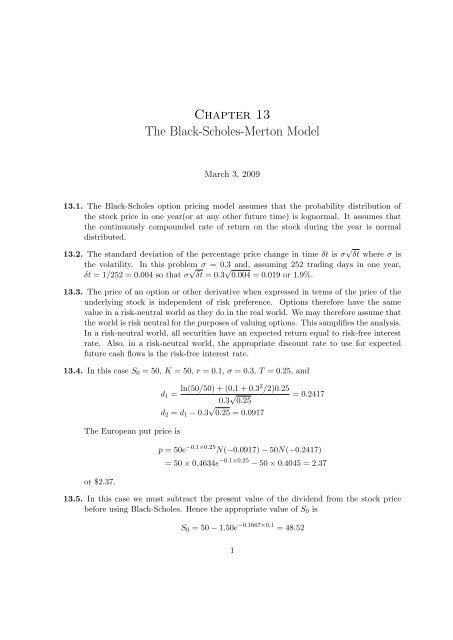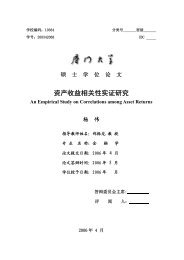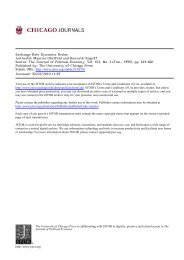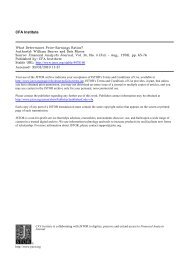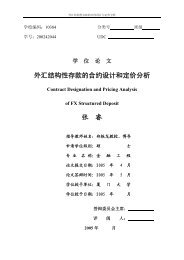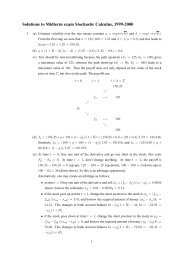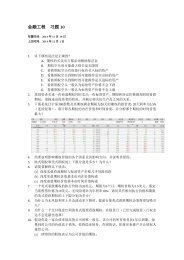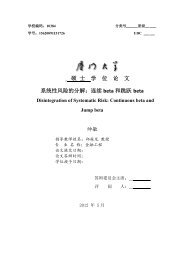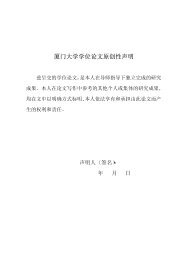Chapter 13 The Black-Scholes-Merton Model
Chapter 13 The Black-Scholes-Merton Model
Chapter 13 The Black-Scholes-Merton Model
Create successful ePaper yourself
Turn your PDF publications into a flip-book with our unique Google optimized e-Paper software.
<strong>Chapter</strong> <strong>13</strong><strong>The</strong> <strong>Black</strong>-<strong>Scholes</strong>-<strong>Merton</strong> <strong>Model</strong>March 3, 2009<strong>13</strong>.1. <strong>The</strong> <strong>Black</strong>-<strong>Scholes</strong> option pricing model assumes that the probability distribution ofthe stock price in one year(or at any other future time) is lognormal. It assumes thatthe continuously compounded rate of return on the stock during the year is normaldistributed.<strong>13</strong>.2. <strong>The</strong> standard deviation of the percentage price change in time δt is σ √ δt where σ isthe volatility. In this problem σ = 0.3 and, assuming 252 trading days in one year,δt = 1/252 = 0.004 so that σ √ δt = 0.3 √ 0.004 = 0.019 or 1.9%.<strong>13</strong>.3. <strong>The</strong> price of an option or other derivative when expressed in terms of the price of theunderlying stock is independent of risk preference. Options therefore have the samevalue in a risk-neutral world as they do in the real world. We may therefore assume thatthe world is risk neutral for the purposes of valuing options. This samplifies the analysis.In a risk-neutral world, all securities have an expected return equal to risk-free interestrate. Also, in a risk-neutral world, the appropriate discount rate to use for expectedfuture cash flows is the risk-free interest rate.<strong>13</strong>.4. In this case S 0 = 50, K = 50, r = 0.1, σ = 0.3, T = 0.25, andd 1 = ln(50/50) + (0.1 + 0.32 /2)0.250.3 √ 0.25d 2 = d 1 − 0.3 √ 0.25 = 0.0917= 0.2417<strong>The</strong> European put price isor $2.37.p = 50e −0.1×0.25 N(−0.0917) − 50N(−0.2417)= 50 × 0.4634e −0.1×0.25 − 50 × 0.4045 = 2.37<strong>13</strong>.5. In this case we must subtract the present value of the dividend from the stock pricebefore using <strong>Black</strong>-<strong>Scholes</strong>. Hence the appropriate value of S 0 isS 0 = 50 − 1.50e −0.1667×0.1 = 48.521
As before K = 50, r = 0.1, σ = 0.3 and T = 0.25. In this caseln(48.52/50) + (0.1 + 0.09/2)0.25d 1 =0.3 √ 0.25d 2 = d 1 − 0.3 √ 0.25 = −0.1086= 0.0414<strong>The</strong> European put price isor $3.03.50N(0.1086)e −0.1×0.25 − 48.52N(−0.0414)= 50 × 0.5432e −0.1×0.25 − 48.52 × 0.4835 = 3.03<strong>13</strong>.6. <strong>The</strong> implied volatility is the volatility that makes the <strong>Black</strong>-<strong>Scholes</strong> price of an optionequal to its market price. It is calculated using an iterative procedure.<strong>13</strong>.7. In this case, µ = 0.15 and σ = 0.25. From equation (<strong>13</strong>.7), the probability distributionfor the rate of return over a 2-year period with continuous compounding isφ(0.15 − 0.2522 , 0.25 )√2i.e.,φ(0.11875, 0.1768)<strong>The</strong> expected value of the ruturn is 11.875% per annum and the standard deviation is17.68% per annum.<strong>13</strong>.8. (a) <strong>The</strong> required probability is the probability of the stock price being above $40 insix months’ time. Suppose that the stock price in six months is S T[)ln S T ∼ φ ln 38 +(0.16 − 0.352 0.5, 0.35 √ ]0.52i.e.,ln S T ∼ φ(3.687, 0.247)Since ln 40 = 3.689, the required probability is( )3.689 − 3.6871 − N= 1 − N(0.008)0.247From normal distribution tables N(0.008) = 0.5032, so that the required probabilityis 0.4968. In general the required probability is N(d 2 ).(b) In this case, the required probability is the probability of the stock price being lessthan $40 in six months’ time. It is1 − 0.4968 = 0.50322
<strong>13</strong>.9. From equation (<strong>13</strong>.3),[ln S T ∼ φ ln S 0 +) (µ − σ2T, σ √ ]T2Thus the 95% confidence intervals for ln S T are therefore)ln S 0 +(µ − σ2T − 1.96σ √ T2andln S 0 +95% confidence intervals for S T ’s are therefore) (µ − σ2T + 1.96σ √ T2e ln S 0+(µ−σ 2 /2)T −1.96σ √ Tandi.e.,ande ln S 0+(µ−σ 2 /2)T +1.96σ √ TS 0 e (µ−σ2 /2t)T −1.96σ √ TS 0 e (µ−σ2 /2)T +1.96σ √ T<strong>13</strong>.10. <strong>The</strong> statement is misleading in that a certain sum of money, say $1000, when investedfor 10 years in the fund would have realized a return (with annual compounding) of lessthan 20% per annum.<strong>The</strong> average of the returns realized in each year is always greater than the return per annum(withannual compounding) realized over 10 years.<strong>The</strong> first is an arithmetic averageof the returns in each year; the second is a geometric average of these returns.<strong>13</strong>.11. (a) At time t, the expected value of ln S T is, from equation (<strong>13</strong>.3)ln S +) (µ − σ2(T − t)2In a risk-neutral world, the expected value of ln S T is therefore:)ln S +(r − σ2(T − t)2Using risk-neutral valuation, the value of the security at time t is:) ]e[ln −r(T −t) S +(r − σ2(T − t)23
(b) If:thenf = e −r(T −t) [ln S +[∂f∂t = re−r(T −t) ln S +∂f e−r(T−t)=∂S S∂ 2 f−t)= −e−r(T∂S2 S 2) ](r − σ2(T − t)2) (r − σ2(T − t)2] )− e(r −r(T −t) − σ22<strong>The</strong> left-hand side of the <strong>Black</strong>-<strong>Scholes</strong>-<strong>Merton</strong> differential equation is)) ]e[r −r(T −t) ln S + r(r − σ2(T − t) −(r − σ2+ r − σ222 2) ]=re[ln −r(T −t) S +(r − σ2(T − t)2=rfHence equation (<strong>13</strong>.16) is satisfied.<strong>13</strong>.12. This problem is related to Problem 12.10.(a) If G(S, t) = h(t, T )S n , then ∂G/∂t = h t S n , ∂G/∂S = hnS n−1 , and ∂ 2 G/∂S 2 =hn(n − 1)S n−2 , where h t = ∂h/∂t. Substituting into the B-S-M differential equation,we obtainh t + rhn + 1 2 σ2 hn(n − 1) = rh(b) <strong>The</strong> derivative is worth S n when t = T . <strong>The</strong> boundary condition for this differentialequation is therefore h(T, T ) = 1.(c) <strong>The</strong> equationh(t, T ) = e [0.5σ2 n(n−1)+r(n−1)](T −t)satisfies the boundary condition, since it collapses to h = 1 when t = T . It canalso be shown that it satisfies the differential equation in (a). Alternatively we canalso solve the differential equation in (a) directly. <strong>The</strong> differential equation can bewrittenh th = −r(n − 1) − 1 2 σ2 n(n − 1)<strong>The</strong> solution to this isln h = [−r(n − 1) − 1 2 σ2 n(n − 1)]t + kwhere k is a constant. Since ln h = 0 when t = T , it follows thatk = [r(n − 1) + 1 2 σ2 n(n − 1)]T4
So thatorln h = [−r(n − 1) + 1 2 σ2 n(n − 1)](T − t)h(t, T ) = e [0.5σ2 n(n−1)+r(n−1)](T −t)<strong>13</strong>.<strong>13</strong>. In this case S 0 = 52, K = 50, r = 0.12, σ = 0.3 and T = 0.25.d 1 = ln(52/50) + (0.12 + 0.32 /2)0.250.3 √ 0.25d 2 = d 1 − 0.3 √ 0.25 = 0.3865= 0.5365<strong>The</strong> price of the European call is52N(0.5365) − 50e −0.12×0.25 N(0.3865)= 52 × 0.7042 − 50e −0.03 × 0.6504 = 5.06or $5.06.<strong>13</strong>.14. In this case S 0 = 69, K = 70, r = 0.05, σ = 0.35 and T = 0.5.d 1 = ln(69/70) + (0.05 + 0.352 /2) × 0.50.35 √ 0.5d 2 = d 1 − 0.35 √ 0.5 = −0.0809= 0.1666<strong>The</strong> price of the European put is70e −0.05×0.5 N(0.0809) − 69N(−0.1666)= 70e −0.025 × 0.5323 − 69 × 0.4338 = 6.40or $6.40.<strong>13</strong>.15. Using the notation in Section <strong>13</strong>.12, D 1 = D 2 = 1, andK[1 − e −r(t 2−t 1 ) ] = 65[1 − e −0.1×0.25 ] = 1.60K[1 − e −r(T −t2) ] = 65[1 − e −0.1×0.1667 ] = 1.07SinceandD 1 < K[1 − e −r(t 2−t 1 ) ]D 2 < K[1 − e −r(T −t 2) ]So it is never optimal to exercise the call option early. DerivaGem shows that the valueof the option is 10.94.5
<strong>13</strong>.16. In the case c = 2.5, S 0 = 15, K = <strong>13</strong>, T = 0.25, r = 0.05. <strong>The</strong> implied volatility mustbe caculated using an interative procedure.A volatility of 0.2 (or 20% per annum) gives c = 2.20. A volatility of 0.3 gives c = 2.32.A volatility of 0.4 gives c = 2.507. A volatility of 0.39 gives c = 2.487. By interpolationthe implied volatility is about 0.397 or 39.7% per annum.<strong>13</strong>.17. (a) Since N(x) is the cumulative probability that a variable with a standardizednormal distribution will be less than x, N ′ (x) is the probability density functionfor a standardized normal distribution, that is,(b)N ′ (x) = 1 √2πe −x2 /2(c)BecauseIt follows thatAs a resultN ′ (d 1 ) = N ′ (d 2 + σ √ T − t)= √ 1 []exp − d2 22π 2 − σd √ 12 T − t −2 σ2 (T − t)[]= N ′ √ 1(d 2 )exp −σd 2 T − t −2 σ2 (T − t)Which is the required result.HenceSimilarlyand<strong>The</strong>refore:d 2 = ln(S/K) + (r − σ2 /2)(T − t)σ √ T − t[]√ 1exp −σd 2 T − t −2 σ2 Ke−r(T−t)(T − t) =SSN ′ (d 1 ) = Ke −r(T −t) N ′ (d 2 )d 1 = ln(S/K) + (r + σ2 /2)(T − t)σ √ T − t∂d 1∂S = 1Sσ √ T − td 2 = ln(S/K) + (r − σ2 /2)(T − t)σ √ T − t∂d 2∂S = 1Sσ √ T − t∂d 1∂S = ∂d 2∂S6
(d)c = SN(d 1 ) − Ke −r(T −t) N(d 2 )∂c∂t = SN ′ (d 1 ) ∂d 1∂t − rKe−r(T −t) N(d 2 ) − Ke −r(T −t) N ′ (d 2 ) ∂d 2∂tFrom (b):SN ′ (d 1 ) = Ke −r(T −t) N ′ (d 2 )HenceSinceHence(∂c∂t = −rKe−r(T −t) N(d 2 ) + SN ′ ∂d1(d 1 )∂t − ∂d )2∂td 1 − d 2 = σ √ T − t∂d 1∂t − ∂d 2∂t = ∂ ∂t (σ√ T − t)σ= −2 √ T − t∂c∂t = −rKe−r(T −t) N(d 2 ) − SN ′ σ(d 1 )2 √ T − t(e) From differentiating the <strong>Black</strong>-<strong>Scholes</strong> formula for a call price we obtain∂c∂S = N(d 1) + SN ′ (d 1 ) ∂d 1∂S − Ke−r(T −t) N(d 2 ) ∂d 2∂SFrom the results in (b) and (c), it follows that∂c∂S = N(d 1)(f) Differentiating the result in (e) and using the result in (c), we obtainFrom the result in (d) and (e)∂ 2 c∂S 2 = N ′ (d 1 ) ∂d 1∂S= N ′ 1(d 1 )Sσ √ T − t∂c ∂c+ rS∂t ∂S + 1 2 σ2 S 2 ∂2 c∂S 2= − rKe −r(T −t) N(d 2 ) − SN ′ σ(d 1 )2 √ T − t + rSN(d 1) + 1 2 σ2 S 2 N ′ 1(d 1 )Sσ √ T − t=r[SN(d 1 ) − Ke −r(T −t) N(d 2 )]=rcThis shows that the <strong>Black</strong>-<strong>Scholes</strong> formula for a call option does indeed satisfy the<strong>Black</strong>-<strong>Scholes</strong> differencial equation.7
(g) If S ≥ K, then d 1 , d 2 → +∞ as t → T , N(d 1 ) = N(d 2 ) = 1. From (d), c = S − K.If S < K, then d 1 , d 2 → −∞ as t → T , N(d 1 ) = N(d 2 ) = 0. From (d), c = 0.<strong>The</strong>refore c satisfies the boundary condition for a European call option, i.e., thatc = max(S − K, 0) as t → T .<strong>13</strong>.18. From the <strong>Black</strong>-<strong>Scholes</strong> equationsBecause 1 − N(−d 1 ) = N(d 1 ), this isAlso:p + S 0 = Ke −rT N(−d 2 ) − S 0 N(−d 1 ) + S 0Ke −rT N(−d 2 ) + S 0 N(d 1 )c + Ke −rT = S 0 N(d 1 ) − Ke −rT N(d 2 ) + Ke −rTBecause 1 − N(d 2 ) = N(−d 2 ), this is alsoKe −rT N(−d 2 ) + S 0 N(d 1 )<strong>The</strong> <strong>Black</strong>-<strong>Scholes</strong> equations are therefore consistent with put-call parity.<strong>13</strong>.19. This problem naturally leads on to the material in <strong>Chapter</strong> 18 on volatility smiles.Using DerivaGem we obtain the following table of implied volatilities:Maturity (months)Strike price ($) 3 6 1245 37.78 34.99 34.0250 34.15 32.78 32.0355 31.98 30.77 30.45<strong>The</strong> option prices are not exactly consistent with <strong>Black</strong>-<strong>Scholes</strong>. If they were, the impliedvolatilities would be all the same. We usually find in practice that low strike price optionson a stock have significantly higher implied volatilities than high strike price options onthe same stock.<strong>13</strong>.20. <strong>Black</strong>’s approach in effct assumes that the holder of option must decide at time zerowhether it is a European option maturing at time t n (the final ex-dividend date) or aEuropean option maturing at time T . In fact the holder of the option has more flexibilitythan this. <strong>The</strong> holder can choose to exercise at time t n if the stock price at that time isabove some level but not otherwise. Furthermore, if the option is not exercised at timet n , it can still be exercised at time T .It appears that <strong>Black</strong>’s approach understates the ture option value. This is because theholder of the option has more alternative strategies for decideing when to exercise theoption than the two alternatives implicitly assumed by the approach. <strong>The</strong>se alternativesadd value to the option.8
<strong>13</strong>.21. With the notation in the text, D 1 = D 2 = 1.50, t 1 = 1/3 , t 2 = 5/6, T = 1.25, r = 0.08and K = 55K[1 − e −r(T −t 2) ] = 55[1 − e −0.08×0.4167 ] = 1.80HenceAlso:Hence:D 2 < K[1 − e −r(T −t 2) ]K[1 − e −r(t 2−t 1 ) ] = 55[1 − e −0.08×0.5 ] = 2.16D 1 < K[1 − e −r(t 2−t 1 ) ]It follows from the conditions established in Section <strong>13</strong>.12 that the option should neverbe exercised early.<strong>The</strong> present value of the dividends is1.5e −0.08×1/3 + 1.5e −0.08×5/6 = 2.8638<strong>The</strong> option can be valued using the European pricing formula with:and the call price isor $4.17.S 0 = 50 − 2.8638 = 47.<strong>13</strong>62, K = 55, σ = 0.25, r = 0.08, T = 1.25d 1 = ln(47.<strong>13</strong>62/55) + (0.08 + 0.252 /2)1.250.25 √ 1.25d 2 = d 1 − 0.25 √ 1.25 = −0.3340N(d 1 ) = 0.4783, N(d 2 ) = 0.3692= −0.054547.<strong>13</strong>62 × 0.4783 − 55e −0.08×1.25 × 0.3692 = 4.17<strong>13</strong>.22. <strong>The</strong> probability that the call option will be exercised is the probability that S T ≥ Kwhere S T is the stock price at time T . In a risk neutral world,[)ln S T ∼ φ ln S 0 +(r − σ2T, σ √ ]T2<strong>The</strong> probability that S T ≥ K is the same as the probability that ln S T ≥ ln K. This is( ln K − ln S0 − (r − σ 2 ) (/2)T1 − Nσ √ ln(S0 /K) + (r − σ 2 )/2)T= NTσ √ = N(d 2 )T<strong>The</strong> expected value at time T in a risk neutral world of a derivative security which paysoff $100 when S T ≥ K is therefore100N(d 2 )From risk neutral valuation the value of the security at time t is100e −rT N(d 2 )9
<strong>13</strong>.23. If f = S −2r/σ2 , then∂f∂t∂f∂t = 0∂f∂S = − 2r 2rS− σσ2 2 −1∂ 2 f∂S 2 = 2r ( ) 2rσ 2 σ 2 + 1 S − 2rσ 2 −2+ rS∂f∂S + 1 2 σ2 S 2 ∂2 f∂S 2 = rS−2r/σ2 = rfThis show that the <strong>Black</strong>-<strong>Scholes</strong> equation is satisfied. S −2r/σ2 could therefore be theprice of a traded security.<strong>13</strong>.24. No. This is mainly because when markets are efficient the impact of dilution fromexecutive stock options or warrants is reflected in the stock price as soon as they areannounced and does not need to be taken into account again when the options are valued.<strong>13</strong>.25. In this case, S 0 = K = 50, r = 0.05, σ = 0.25, T = 5, N = 10, 000, 000 andM = 3, 000, 000. From Section <strong>13</strong>.10, the value of each employee option is the value ofN/(N + M) regular call options on the company’s stock, and the total cost is M timesthis.Thus applying <strong>Black</strong>-<strong>Scholes</strong> Formula,d 1 = ln(50/50) + (0.05 + 0.252 /2)50.25 √ 5d 2 = d 1 − 0.25 √ 5 = 0.1677.= 0.7267,<strong>The</strong> regular European call price isc = 50N(0.7267) − 50e −0.05×5 N(0.1677),= 16.2517.<strong>The</strong>refore the cost to the company of the employee stock option issue isor $37,503,923.08.M ·NN + M · c=3, 000, 000 ×=37, 503, 923.08,10, 000, 00010, 000, 000 + 3, 000, 000 × 16.2517,<strong>13</strong>.26. In this case, S 0 = 50, µ = 0.18, σ = 0.3. <strong>The</strong> probability distribution of the stockprice in two years, S T , is lognormal and is, from equation (<strong>13</strong>.3), given by:[ (ln S T ∼ φ ln 50 + 0.18 − 0.09 )2, 0.3 √ ]2210
i.e.,ln S T ∼ φ(4.18, 0.42)<strong>The</strong> mean stock price is from equation (<strong>13</strong>.4)50e 0.18×2 = 50e 0.36 = 71.67and the standard deviation is, from equation (<strong>13</strong>.5)50 2 e 2×0.18√ e 0.09×2 − 1 = 31.8395% confidence intervals for ln S T are4.18 − 1.96 × 0.42 and 4.18 + 1.960.42i.e.,3.35 and 5.01<strong>The</strong>se correspond to 95% confidence limits for S T ofe 3.35 and e 5.01i.e.,28.52 and 150.44<strong>13</strong>.27. <strong>The</strong> calculation are shown in the table belowΣu i = 0.09471 Σu 2 i = 0.01145and an estimate of standard deviation of weekly return is :√0.01145− 0.094712<strong>13</strong> 14 × <strong>13</strong> = 0.02884<strong>The</strong> volatility per annum of 0.0288 √ 52 = 0.2079, or 20.79%. <strong>The</strong> standard error of thisestimate is0.2079√ = 0.03932 × 14or 3.93% per annum.11
Computation of VolatilityWeek Closing stock price Price relative Weekly return($) S i /S i−1 u i = ln(S i /S i−1 )1 30.22 32.0 1.0596 0.05793 31.1 0.9719 −0.02854 30.1 0.9678 −0.03275 30.2 1.0033 0.00336 30.3 1.0033 0.00337 30.6 1.0099 0.00998 33.0 1.0784 0.07559 32.9 0.9970 −0.003010 33.0 1.0030 0.003011 33.5 1.0152 0.015112 33.5 1.0000 0.0000<strong>13</strong> 33.7 1.0060 0.006014 33.5 0.9941 −0.005915 33.2 0.9910 −0.0090<strong>13</strong>.28. (a) <strong>The</strong> expected value of the security is E[ST 2 ]. From equations (<strong>13</strong>.4) and (<strong>13</strong>.5),at time t:µ(T −t)E(S T ) = Sevar(S T ) = S 2 e 2µ(T −t) (e σ2 (T −t) − 1)Since var(S T ) = E(S 2 T ) − [E(S T )] 2 , it follows that E(S 2 T ) = var(S T ) + [E(S T )] 2 , sothatE(S 2 T ) = S 2 e 2µ(T −t) + S 2 e 2µ(T −t) (e σ2 (T −t) − 1)= S 2 e (2µ+σ2 )(T −t)In a risk-neutral world µ = r, so thatEˆ(S 2 T ) = S 2 e (2r+σ2 )(T −t)Using risk-neutral valuation,the value of the derivative security at time t ise −r(T −t) Eˆ(S 2 T )= S 2 e (2r+σ2 )(T −t) −r(T −t)e= S 2 e (r+σ2 )(T −t)(b) Iff = S 2 e (r+σ2 )(T −t)12
then∂f∂t = −S2 (r + σ 2 )e (r+σ2 )(T −t)∂f∂S = 2Se(r+σ2 )(T −t)∂ 2 f∂S 2 = 2e(r+σ2 )(T −t)<strong>The</strong> left-hand side of the <strong>Black</strong>-Scholses differential equation is:− S 2 (r + σ 2 )e (r+σ2 )(T −t) + 2rS 2 e (r+σ2 )(T −t) + σ 2 S 2 e (r+σ2 )(T −t)=rS 2 e (r+σ2 )(T −t)=rfHence the <strong>Black</strong>-Scholses equation is satisfied.<strong>13</strong>.29. In this case S 0 = 30, K = 29, r = 0.05, σ = 0.25 and T = 1/3.d 1 = ln(30/29) + (0.05 + 0.252 /2)/30.25 √ 1/3d 2 = d 1 − 0.25 √ 1/3 = 0.2782= 0.4225(a) <strong>The</strong> European call price isor $2.52.N(0.4225) = 0.6637 N(0.2782) = 0.6096N(−0.4225) = 0.3363 N(−0.2782) = 0.390430 × 0.6637 − 29e −0.05/3 × 0.6096 = 2.52(b) <strong>The</strong> American call price is the same as the European call price. It is $2.52.(c) <strong>The</strong> European put price isor $1.05.(d) Put-call parity states that:29e −0.05/3 × 0.3904 − 30 × 0.3363 = 1.05c + Ke −rT = p + S 0In this case c = 2.52, S 0 = 30, K = 29, p = 1.05 and e −rT = 0.9835 and it is easyto verify that the relationship is satisfied.<strong>13</strong>
<strong>13</strong>.30. (a) <strong>The</strong> present value of the dividend must be subtracted from the stock price. Thisgives a new stock price of:and30 − 0.5e −0.125×0.05 = 29.5031d 1 = ln(29.5031/29) + (0.05 + 0.252 /2)/30.25 √ 1/3d 2 = d 1 − 0.25 √ 1/3 = 0.1625= 0.3068<strong>The</strong> price of the option is thhereforeor $2.21.(b) SinceN(d 1 ) = 0.6205, N(d 2 ) = 0.564529.5031 × 0.6205 − 29e −0.05/3 × 0.5645 = 2.21N(−d 1 ) = 0.3795; N(−d 2 ) = 0.4355the value of the option when it is a European put isor $1.22.29e −0.05/3 × 0.4355 − 29.5031 × 0.3795 = 1.22(c) If t 1 denotes the time when the dividend is paid:K[1 − e −r(T −t 1) ] = 29(1 − e −0.05×0.2083 ) = 0.3005This is less than the dividend. Hence the option should be exercised immediatelybefore the ex-dividend date for a sufficiently high value of the stock price.<strong>13</strong>.31. We first value the option assuming that it is not exercised early, we set the time tomaturity equal to 0.5. <strong>The</strong>re is a dividend of 0.4 in 2 months and 5 months. Otherparameters are S 0 = 18, K = 20, r = 10%, σ = 30%. DerivaGem gives the price as0.7947. We next value the option assuming that it is exercised at the five-month pointjust before the final dividend. DerivaGem gives the price as 0.7668. <strong>The</strong> price givenby <strong>Black</strong>’s approximation is therefore 0.7947. DerivaGem also shows that the correctAmerican option price calculate with 100 time steps is 0.8243.It is never optimal to exercise the option immediately before the first ex-dividend datewhenD 1 ≤ K[1 − e −r(t 2−t 1 ) ]Where D 1 is the size of the frist dividend, and t 1 and t 2 are the times of the first andsecond dividend respectively. Hence we must have:D 1 ≤ 20[1 − e −0.1×0.25 ]14
that is,D 1 ≤ 0.494It is never optimal to exercise the option immediately before the second ex-dividenddate when:D 2 ≤ K[1 − e −r(T −t 2) ]Where D 2 is the size of the second dividend. Hence we must have:that is,D 2 ≤ 20[1 − e −0.1×0.0833 ]D 2 ≤ 0.166It follows that the dividend can be as high as 16.6 cents per share without the Americanoption being worth more than the corresponding European option.15


